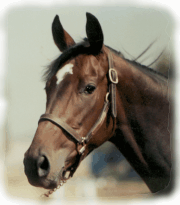|

|
A
Horse, Of Course
by Don Blazer |
If
you love that new foal, don’t feed him--too much!
Yes, I know he’s cute, and you can’t resist. Yes, I
know you want him to have the very best. Yes, I know his little
ribs are showing just a bit.
That’s the way he is supposed to be!
Feed him too much, make him fat, and he may be a cripple for life.
Epiphysitis—an inflammation of the epiphyseal plate--is caused
by a number of factors, excessive weight being first on the list.
The disease occurs in foals ranging in age from one to nine months,
and we usually associate it with the knee and fetlock joint although
it can occur on any bone. On each end of the shaft of long bone
is the epiphysis (epiphyseal plate) which is cartilage which hasn’t
yet turned to bone.
This
cartilage or soft bone maintains its natural shape as the young
horse grows, unless it is “squashed” out of shape by
the foal’s own weight. When it is “squashed,” it
is often called “big ankles”, “double ankles”,
or “hour-glass ankles or knee.” The distinctive hour-glass
shape is the result of the epiphyseal plate flattening under the
horse’s weight and widening above and below the joint.
Sometimes—but
not often—there is no lameness associated with the condition.
However, if not recognized and left uncorrected, epiphysitis can
and often does result in crippling arthritis.
Excessive
weight and a lack of exercise rank as the number one culprit.
The disease is almost always seen in the biggest, fattest individuals
in the herd. The dams of these foals produce lots of milk and
the weight of the foal is simply too much for the epiphyseal plate.
Since 65% of the horse’s weight is carried on the forelegs
when he is idle, the disease is most often seen first in the front
legs.
Foals
kept in small areas—and there are way too many of them—are
at greater risk for the disease. No exercise, no strengthening
of young bones. No exercise, greater chance for a fatter, softer
foal.
Other
causes include an imbalance in calcium and phosphorous, usually
the result of “trying to fatten and build up the young horse.”
The
minerals calcium and phosphorous should be kept in ratio—somewhere
between 1:1 and 2:1. When a young horse is being fed a lot of
grain to “build him”, the ratio gets out of balance.
Grains are high in phosphorous and if the phosphorous gets too
high, calcium will be then be called from the bone to restore
the balance within the blood. The resulting effort is softer bone,
and eventually epiphysitis.
Another
factor affecting bone development is heredity. Certain inherited
factors cause late maturing bone, while other factors cause soft
bone. When those factors are combined, the young horse is at high
risk for epiphysitis. Be careful in selecting mares and stallions.
Since
nutrition can be regulated, that is the first place to start in
an effort to protect the young horse.
Most
breeders and veterinarians agree that a foal which is showing
signs of epiphysitis should be weaned immediately, regardless
of age. A blood panel should be run to determine the Ca and P
ratio. Depending on the blood results, the young horse may need
supplements of calcium or phosphorous. Supplements need to be
used judiciously.
Even
after you correct any nutritional problem, the disease process
may not shows signs of being curtailed for weeks.
The
best thing you can do for any foal is see to it he gets plenty
of exercise, has a balanced, but not growth inducing, diet, has
an abundance of clean, cool water and enjoys fresh air—even
without sunshine.
Then
enjoy watching him grow—on his own.
*****************************************************************
Read,
ride, reason. Visit www.donblazer.com
for answers to your questions about horses.
.







